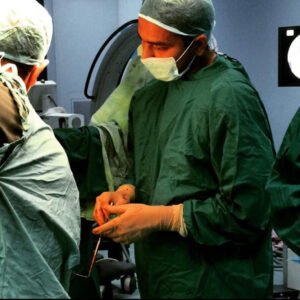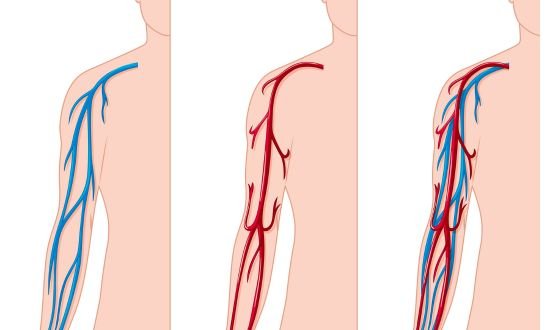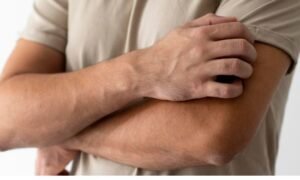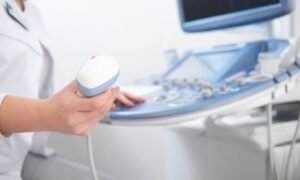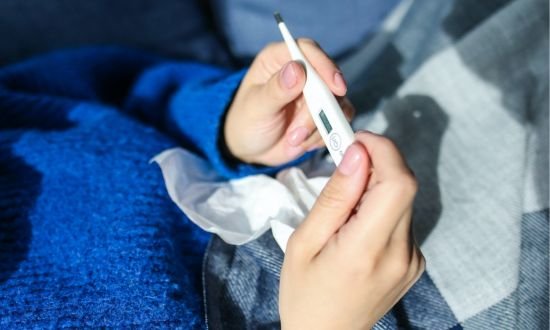Varicose veins are a common condition that often affect the legs and feet. However, they can also occur in the arms and hands, although this is considered a rare occurrence. It is important to discuss varicose veins in arms or hands to ensure a comprehensive understanding of this condition. This article aims to provide a detailed guide on varicose veins in arms or hands, including their causes, symptoms, prevention and treatment strategies.
Table of Contents
ToggleWhat are Varicose Veins?
Varicose veins are twisted and enlarged veins due to malfunctioning veins valves. Improper functioning of veins valves results in pooling of blood and increased pressure within the veins.
Difference of Varicose Veins from Normal Veins
Unlike normal veins, which have valves that allow blood to flow in one direction towards the heart, varicose veins have weakened valves that allow blood to flow backward and pool within the veins. This causes the veins to become enlarged and bulging.
Varicose veins in Arms or Hands: A Rare Occurrence
While varicose veins are commonly found in the lower extremities, they rarely occur in the arms and hands. When they do occur in these areas, they often result from underlying medical conditions or occupational factors.
Causes and Risk Factors
Varicose veins in the arms and hands can be influenced by various causes and risk factors. These include:
- Family History
A family history of varicose veins increases the chances of developing varicose veins. Certain genetic factors can contribute to weakened vein walls and valves, making individuals more susceptible to varicose veins.
- Sedentary Lifestyle
A sedentary lifestyle and lack of regular physical activity can contribute to the development of varicose veins. Lack of movement reduces muscle contractions that help pump blood back to the heart, increasing the likelihood of blood pooling in the veins.
- Hormonal Changes and Pregnancy
Hormonal changes during pregnancy, as well as fluctuations in hormone levels in general, can weaken vein walls and valves, leading to the development of varicose veins. The increased volume of blood during pregnancy also puts additional pressure on the veins.
- Occupational Factors
Certain occupations that involve repetitive arm movements or prolonged periods of standing can increase the risk of varicose veins in the arms and hands. These movements and postures can lead to increased pressure within the veins, contributing to their enlargement.
- Obesity
Being overweight or obese can put added pressure on the veins throughout the body, including those in the arms and hands. The excess weight can impair proper blood flow and increase the risk of varicose vein development.
- Other Associated Risk factors
Other risk factors for varicose veins in arms or hands includes:
- Aging
- Gender (women are more susceptible)
- Previous blood clotting disorders.
Other Causes of Bulging Veins in Arms or Hands
- Exercise: If you do intense workouts, like lifting weights, your veins in your hands and arms might stand out more. That’s because exercise boosts blood flow and muscle growth, making veins more visible under your skin.
- Low-calorie diet: When you follow a low-calorie diet and lose body fat, your veins, especially in your hands and arms, can become more obvious as your body fat decreases.
- Aging: Getting older can make your veins more visible. It not only increases the chance of varicose veins but also thins and makes your skin less elastic, which makes your veins easier to see.
- Medical conditions: Certain health issues, like vasculitis (inflammation of blood vessels) or chronic venous insufficiency (poor vein function), can cause bulging veins as well.
Symptoms of Varicose Veins in Arms or Hands
Varicose veins in the arms or hands can present with various symptoms. These include:
- Visible signs of bulging veins in arms or hands that appear blue or purple
- Itching
- Burning sensation
- Discomfort
- Swelling and heaviness in the affected area
Potential complications
Sometimes varicose veins in arms or hands can lead to following complications:
- Superficial Thrombophlebitis (inflammation of a vein due to a blood clot)
- Skin ulcers which occur when the skin over the affected vein breaks down
- Deep vein thrombosis
- Pulmonary embolism
Diagnosis of Varicose Veins in Arms or Hands
Diagnosing varicose veins in the arms or hands typically involves a combination of medical history evaluation and physical examination. This may include:
- Medical history
- Physical examination
- Duplex ultrasound may be used to evaluate the blood flow with in the veins and identify any abnormalities.
- Venography
- Magnetic resonance imaging (MRI) may be performed to assess the severity of varicose veins and identify any underlying causes.
Treatment of Varicose Veins in Arms or Hands
Treatment options for varicose veins in the arms or hands can vary depending on the severity of the condition. These options include:
Conservative Approaches
- Lifestyle modifications: Regular exercise and weight management can help improve circulation and reduce symptoms associated with varicose veins.
- Compression stockings: Wearing compression stockings can help support the veins, improve blood flow, and alleviate symptoms.
- Elevation and proper positioning: Elevating the affected limbs above heart level and maintaining proper positioning can help reduce swelling and discomfort.
- Natural remedies: Some natural remedies, such as horse chestnut extract or herbal supplements, are believed to promote vein health, although their effectiveness may vary.
Minimally Invasive Procedures
- Sclerotherapy: This procedure involves injecting a solution into the affected veins, causing them to collapse and eventually fade from view.
- Endovenous laser treatment: Laser energy is used to seal off the veins, redirecting blood flow to healthier veins.
- Radiofrequency ablation: Heat energy is employed to close the affected veins, rerouting blood to healthier veins.
Surgical Procedures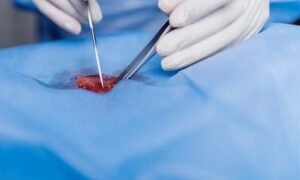
Surgical removal of varicose veins is sometimes necessary for severe cases. Procedure for removal of varicose veins is called phlebectomy. This procedure involves making small incisions and removing the affected veins. It can be of two types:
- Ambulatory phlebectomy : It involves removal of veins through tiny incisions.
- Stab avulsion technique: It involves removal of veins through puncture
Prevention of Varicose veins in Arms or Hands
Lifestyle modifications can promote vein health and minimize the risk of varicose veins in arms or hands. Prevention strategies include:
- Consuming foods rich in antioxidants, flavonoids, and omega-3 fatty acids can support vein health. This includes incorporating citrus fruits, berries, leafy greens, and fatty fish into one’s diet
- Wearing loose-fitting clothing and avoiding tight accessories
- Maintaining proper posture and using ergonomic equipment can minimize strain on the arms and hands
- Regular breaks and movement for individuals with desk jobs
- Elevating the affected limbs
- Regular moisturizing and gentle massage can help improve circulation and maintain skin health.
When to Seek Medical Help?
It is important to know when medical attention is necessary for varicose veins in arms or hands. Immediately consult with doctor in following cases:
- Severe pain or swelling occurs suddenly
- Skin ulcers or sores develop over the affected veins
- Excessive bleeding or a change in skin color is noted
- Symptoms significantly impact daily life or sleep quality
Consulting a healthcare professional will ensure proper diagnosis and appropriate treatment options.
Frequently Asked Questions
1. Can varicose veins in arms or hands be prevented?
Yes, they can be prevented by staying active, maintaining a healthy weight, and practicing good posture.
2. Are varicose veins in arms or hands only a cosmetic concern?
No, they can cause discomfort and complications, not just a cosmetic issue.
3. Can exercise worsen varicose veins in the upper body?
Intense upper body exercise can worsen varicose veins. Balance is key.
4. Are there any home remedies to alleviate symptoms?
Yes, elevating the arm, using compression stockings and cold compresses can help.
5. How long does the recovery process take after surgical intervention?
Recovery time varies but can range from days for minimally invasive procedures to weeks for surgery. Follow your doctor’s guidance for a safe recovery.
Conclusion
In conclusion, while varicose veins in arms or hands may be rare, they can still cause discomfort and have potential complications. Understanding the causes, symptoms, diagnosis, and treatment options is vital for managing this condition effectively. With early intervention, lifestyle modifications, and appropriate medical care, individuals can optimize their vascular health and alleviate the symptoms associated with varicose veins in arms or hands.
Disclaimer
Content on this site is written with thorough research and keeping in mind the latest guidelines. However, no content on this site should substitute professional consultation.

